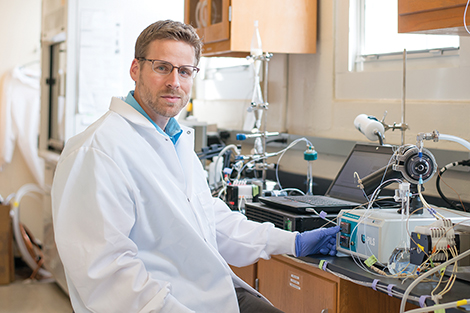Bright Futures
UMBC’s growing reputation as a hub for research with powerful impact isn’t founded on the achievements of renowned scholars who have created laboratories or explored the limits of the arts, humanities and social sciences at the university alone. It is also built on a growing number of impressive younger scholars who have found a home for their work at UMBC.
The pedigree of the scholars who will propel research and teaching at the university in its next 50 years can be measured in part by the number of early career teaching and research awards these up-and-coming faculty members have received.
One of the most prestigious of these honors is the National Science Foundation’s Early Career Development (CAREER) award, which was created to support “junior faculty who exemplify the role of teacher-scholar through outstanding research, excellent education, and the integration of education and research within the context of the mission of their organizations.” UMBC faculty members have received 29 NSF CAREER awards over the last two decades.
UMBC Magazine would like to introduce you to some of the faculty who represent the bright future for research and teaching at UMBC – and how they are already making their mark on academia and the world.
Christopher Hennigan
Everyone dreads a bad air day when it pops up on a weather forecast, but knowing how those conditions are created is essential to finding ways to ameliorate or prevent the damage to health and climate.
Christopher Hennigan, assistant professor of chemical, biochemical, and environmental engineering, is at the forefront of analyzing these issues. His work focuses on pollutants known as particulate matter or aerosols—small particles in the air that have detrimental effects on human health and important implications for climate change.
This work has come to the attention of the National Science Foundation (NSF), which gave Hennigan a CAREER award of $524,606 to characterize the effects of acid-catalyzed reactions on the atmospheric transformation of volatile organic compounds into secondary organic aerosol (SOA).
SOA is an ubiquitous component in the atmosphere that contributes to aerosol effects on human health and climate, but there has been disagreement between laboratory studies and ambient readings on the role of particle acidity in its formation. So Hennigan and his team are developing new methods to rapidly measure particle acidity through automated system that provides the best combination of high time resolution and accuracy.
When Hennigan’s new technique is deployed, it will provide more accurate models representing SOA formation, thus improving scientists’ ability to make predictions related to ambient aerosol events.
“The five-year duration of the CAREER award is especially advantageous, as it will allow us to push the work forward in a highly significant way,” says Hennigan.
–Dinah Winnick
Posted: August 19, 2016, 8:20 AM
